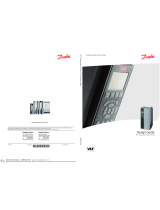
FC 300 Design Guide
Introduction to FC 300
Frequency converters must be CE labelled in accord ance with the low-voltage directive of
January 1, 1997. The dire ctive applies to all electrical equipment and appliances used in the
50 - 1000 V AC and the 75 - 1500 V DC voltage ranges. Da nfoss CE-labels in accordance with
the directive and issues a d eclaration of conformity upon request.
The EMC directive (89/336/EEC)
EMC is short for electromagnetic compatib ility. The presence of electromagne tic compatibility means that the
mutual interference between different com p onents/appliances does not affect the way the appliances work.
The EMC directive came into effect January 1, 1996. Danfoss CE-labels in accordance with the directive and
issues a declaration of conformity upon request. To c arry out EMC-correct installation, see the instructions in
this Design Guid e. In addition, we specify which standards our products c omply with. We offer the filters
presented in the specifications and provide other typ es of assistance to ensure the op timum EMC result.
The frequency converter is most often used by professionals of the trade a s a complex component
forming part of a larger appliance, system or installation. It m ust be noted that the responsibility for
the final EMC properties of the app liance, system or installation rests with the installer.
" What Is Covered
The EU "Guideline s on the Ap plication of Council Directive 8 9/336/EEC" outline three typical situations
of using a frequency converte r. See below for EMC coverage and CE labelling .
1. The frequency converter is sold directly to the end-consumer. The frequen
cy converter is for example
sold t o a DIY market. The end-consume r is a layman. He installs the frequency converter himself
for use with a hobby machine, a kitche n appliance, etc. For such ap plic ations, the frequency
converter must be CE labelled in accordance with the EMC directive.
2. The frequen cy converter is sold for installation in a plant. The plant is built up by professionals of the
trade. It could be a production plant or a heating/ventilation pla nt de signed and installed by professionals
of the trade. Neithe r the f re quency converter nor the finish
ed pla n t has to be CE labelled under the EMC
directive. However, the unit must comply with the b asic EMC requirements of the directive. This is
ensured b y using components, appliances, and systems that are CE labelled under the E MC directive.
3. The frequency converter is sold as part of a complete
system. The system is being m arketed as
complete and could e.g. be an air-conditioning system. The complete system must be CE lab elled
in accordance with the E MC directive. The manufacturer can ensure CE labelling under the EMC
directive either by using CE labelled component
s or by testing the EMC of the syst em . If he chooses
to use only CE labelled components, he does not have to test the entire system.
" Danfoss VLT Frequency Converter
and CE Labelling
CE labelling is a positive feature when used for its orig inal purpose, i.e. to facilitate trade within the E U and EF TA.
However, CE labelling m ay cover many different specifications. Thus, you have to che ck
what a given CE label specifically covers.
The covered specifications can be very diffe rent and a CE labe l may therefore give the installer a false
feeling of security when using a
frequency converter as a component in a system or an appliance.
Danfoss CE labels the frequenc
y converters in accordance with the low-voltage directive. This means that if
the frequency converter is installed correctly, we guarantee compliance with the low-voltage directive. Danfoss
issues a d eclaration of conformity that confirms our CE labelling in accordance with the low-voltage directive.
The CE label also ap plie s to the EM C directive provided that the instructions for EMC -correct installation and
filtering are followed. O
n this basis, a decla ration of conformity in accordance with the EMC directive is issued.
The Design Guide offers d
etailed instructions for installation to ensure EMC-correct installation.
Furthermore, Danfoss specifies which our diffe rent produ cts com pl y with.
16
MG.33.B3.02 - VLT is a registered Danfoss trademark




















